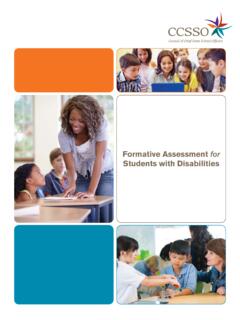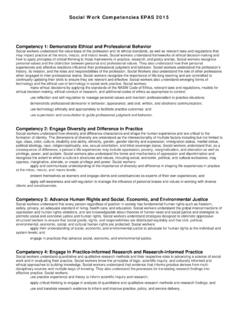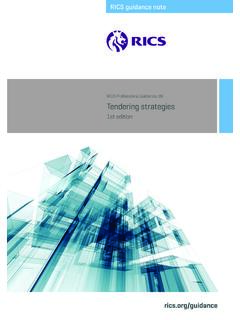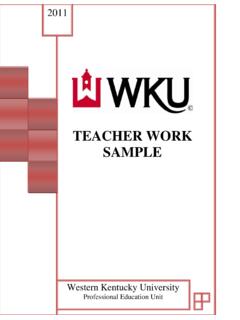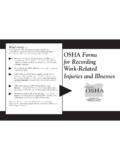Transcription of InTASC - CCSSO
1 Developed byCCSSO s Interstate Teacher Assessment and Support Consortium ( InTASC )April 2011 InTASCM odel Core Teaching Standards: A Resource for State DialogueFor information about how to obtain copies of this document please visit of Chief State School Officers One Massachusetts Avenue, NW, Suite 700 Washington, DC 20001-1431 Phone: 202-336-7000 Fax: 202-408-1938 Suggested Citation: Council of Chief State School Officers. (2011, April). Interstate Teacher Assessment and Support Consortium ( InTASC ) Model Core Teaching Standards: A Resource for State Dialogue. Washington, DC: Author. Copyright 2011 by the Council of Chief State School Officers, Washington, DC. The Council of Chief State School Officers is a nonpartisan, nationwide, nonprofit organization of public officials who head departments of elementary and secondary education in the states, the District of Columbia, the Department of Defense Education Activity, and five extra-state jurisdictions.
2 CCSSO provides leadership, advocacy, and technical assistance on major educational issues. The Council seeks member consensus on major educational issues and expresses their views to civic and professional organizations, federal agencies, Congress, and the public. InTASC Model Core Teaching Standards1 Table of ContentsAcknowledgements ..2 Introduction ..3 Summary of Standards ..8 The Learner and Learning Standard #1: Learner Development ..10 Standard #2: Learning Differences ..11 Standard #3: Learning Environments ..12 Content Knowledge Standard #4: Content Knowledge ..13 Standard #5: Application of Content ..14 Instructional Practice Standard #6: Assessment ..15 Standard #7: Planning for Instruction ..16 Standard #8: Instructional Strategies ..17 Professional Responsibility Standard #9: Professional Learning and Ethical Practice.
3 18 Standard #10: Leadership and Collaboration ..19 Glossary of Terms ..20 Reference Chart of Key Cross-Cutting Themes ..23 InTASC Model Core Standards Update Committee ..24 InTASC Model Core Teaching Standards 2 AcknowledgementsInTASC would like to express its sincere appreciation to the National Education Association, the Educational Testing Service, and Evaluation Systems group of Pearson for providing the funding for this project. We would also like to offer a special thanks to all the InTASC Core Standards Update Committee members who enthusiastically volunteered their time and energy to the challenging task of describing what effective teaching across all content areas and grade levels looks like today. InTASC depends upon the support and input from practicing teachers, teacher educators, and other education professionals such as those on our committee to effectively pursue our mission of providing resources to guide state education policy.
4 Finally, InTASC would like to acknowledge and thank the many national education organizations who worked with us by nominating committee members and helping us spread the word about these standards. These organizations include: American Association of Colleges for Teacher Education (AACTE) American Association of School Administrators (AASA) American Federation of Teachers (AFT) Association of Teacher Educators (ATE) Council for Exceptional Children (CEC) National Association of Elementary School Principals (NAESP) National Association for Gifted Children (NAGC) National Association of Secondary School Principals (NASSP) National Association of State Boards of Education (NASBE) National Association of State Directors of Special Education (NASDSE) National Association of State Directors of Teacher Education and Certification (NASDTEC) National Board for Professional Teaching Standards (NBPTS) National Commission on Teaching and America s Future (NCTAF) National Council for Accreditation of Teacher Education (NCATE) National Education Association (NEA)
5 National School Boards Association (NSBA) National Teacher of the Year Program Teach for America (TFA) Teacher Education Accreditation Council (TEAC) InTASC Model Core Teaching Standards3 IntroductionThe Council of Chief State School Officers ( CCSSO ), through its Interstate Teacher Assessment and Support Consortium ( InTASC ), is pleased to offer this set of model core teaching standards that outline what teachers should know and be able to do to ensure every K-12 student reaches the goal of being ready to enter college or the workforce in today s world. These standards outline the common principles and foundations of teaching practice that cut across all subject areas and grade levels and that are necessary to improve student achievement. More importantly, these Model Core Teaching Standards articulate what effective teaching and learning looks like in a transformed public education system one that empowers every learner to take ownership of their learning, that emphasizes the learning of content and application of knowledge and skill to real world problems, that values the differences each learner brings to the learning experience, and that leverages rapidly changing learning environments by recognizing the possibilities they bring to maximize learning and engage learners.
6 A transformed public education system requires a new vision of New Vision of Teaching for Improved Student AchievementThe updating of the core teaching standards was driven not only by new understandings of learners and learning but also by the new imperative that every student can and must achieve to high standards. Educators are now being held to new levels of accountability for improved student outcomes. These standards embrace this new emphasis and describe what effective teaching that leads to improved student achievement looks like. They are based on our best understanding of current research on teaching practice with the acknowledgement that how students learn and strategies for engaging learners are evolving more quickly than ever. These standards promote a new paradigm for delivering education and call for a new infrastructure of support for professionals in that system.
7 Below are the key themes that run through the updated teaching standards and how they will drive improved student Learning for Diverse LearnersThe explosion of learner diversity means teachers need knowledge and skills to customize learning for learners with a range of individual differences. These differences include students who have learning disabilities and students who perform above grade level and deserve opportunities to accelerate. Differences also include cultural and linguistic diversity and the specific needs of students for whom English is a new language. Teachers need to recognize that all learners bring to their learning varying experiences, abilities, talents, and prior learning, as well as language, culture, and family and community values that are assets that can be used to promote their learning. To do this effectively, teachers must have a deeper understanding of their own frames of reference ( , culture, gender, language, abilities, ways of knowing), the potential biases in these frames, and their impact on expectations for and relationships with learners and their , teachers need to provide multiple approaches to learning for each student.
8 One aspect of the power of technology is that it has made learners both more independent and more collaborative. The core teaching standards assign learners a more active role in determining what they learn, how they learn it, and how they can demonstrate These standards .. describe what effective teaching that leads to improved student achievement looks like. InTASC Model Core Teaching Standards 4their learning. They also encourage learners to interact with peers to accomplish their learning goals. In these ways, the standards embody a vision of teaching that personalizes each learner s experiences while ensuring that every learner achieves to high Stronger Focus on Application of Knowledge and SkillsToday s learners need both the academic and global skills and knowledge necessary to navigate the world attributes and dispositions such as problem solving, curiosity, creativity, innovation, communication, interpersonal skills, the ability to synthesize across disciplines, global awareness, ethics, and technological expertise.
9 CCSSO and the National Governors Association are leading the work on articulating what learners need to know and be able to do. The Common Core State Standards for English Language Arts and Mathematics are benchmarked to international standards and include rigorous content and application of knowledge through high-order skills. As states adopt these standards, educators throughout the nation will be reexamining what students should know and be able to do throughout their K 12 education core teaching standards describe what teachers should know and be able to do in today s learning context to ensure students reach these learning goals. For example, cross-disciplinary skills ( , communication, collaboration, critical thinking, and the use of technology) are woven throughout the teaching standards because of their importance for learners. Additionally, the core teaching standards stress that teachers build literacy and thinking skills across the curriculum, as well as help learners address multiple perspectives in exploring ideas and solving problems.
10 The core teaching standards also address interdisciplinary themes ( , financial literacy, civic literacy) and the teacher s ability to design learning experiences that draw upon multiple Assessment LiteracyThe current education system treats assessment as a function largely separated from teaching. Yet, teachers are expected to use data to improve instruction and support learner success. The core teaching standards recognize that, to meet this expectation, teachers need to have greater knowledge and skill around how to develop a range of assessments, how to balance use of formative and summative assessment as appropriate, and how to use assessment data to understand each learner s progress, adjust instruction as needed, provide feedback to learners, and document learner progress against standards. In addition, teachers need to be prepared to make data-informed decisions at varied levels of assessment, from once-a-year state testing, to district benchmark tests several times a year, to ongoing formative and summative assessments at the classroom-level.

